Farro and Spring Asparagus Salad with Fava Beans, Arugula, Basil and Oil-Cured Tomato Dressing from Chef Lisa Dupar
I’m not a farm girl.
Of course I seek the best quality agriculture products for my never-ending kitchen exploits, but the closest I get to a farm is a trip to the Farmer’s Market or a CSA box.
That no-doubt explains why I was so unprepared for the experience I had on a tour I took April 14, 2013 called Farms, Food and Sustainability, a pre-conference event for attendees of the WA State Academy of Nutrition and Dietetics annual meeting. The term “family farm” took on a new meaning when second-generation owners and brothers Jim and Andy Werkhoven showed us their Monroe Washington dairy farm.
I wasn’t ready for the extraordinary passion expressed by the two men as they shared the story of their lives and work. Their “business” of dairy farming was so much more – a work of the heart and soul, and a true family affair, drawing in wives, children and other relatives, to different degrees and in different capacities it seems, including Andy Werkhoven’s son, who contributes his expertise as a veterinarian.
We got a hint of the Werkhoven’s philosophy to farming on the bus ride to the farm. Kirk Robinson of the Washington State Department of Agriculture ended his overview of our state’s agricultural economy by telling us about the extraordinary attention Washington farmers give to their cows. As he said, a good fate would be to “come back as a dairy cow!”
Jim Werkhoven got straight to the point. “The Cow is Queen!” And when you keep that that the focus, “everything else falls in place,” he explained. The words “happy” kept coming up. Their business revolves around making the lives of cows as stress-free as possible. Want milk? Take care of the cows.
The rural farm setting, gorgeous Holsteins, copious mud and dairy-farm sounds and smells might lead you to think these farmers are running a quaint, old-world operation. That would be wrong.
Both owners “came back to the farm” after college in 1984 and describe the ensuing years as an ongoing process of learning and change to keep up with the best techniques of dairy farming. Evolution is part of the operation. They draw on the expertise of Joe Harrison, PhD, a Professor and Dairy Scientist with Washington State University to plan an optimal diet for their cows. (Dr. Harrison is shown in the photo with some 7 types of feed for the cows.)
Changing the cows’ bedding material from hay, which compacts over time to a hard surface, to sand, made the cows more comfortable and the cows produced more milk. When they gave pregnant cows a dedicated maternity center for 12 days before birth, the mother cows were more content with birthing and delivery outcomes improved.
What is the result of this family’s passionate attention to dairy farming? The farm has grown from 20 cows on 5 acres in 1954 when their father established the farm, to 1,200 cows on 700 acres today.
And not only are they kind to cows, they have reached beyond the boundaries of their own farm in kindness to their neighbors and the environment. Part of an alliance of local dairy producers, the Werkhovens teamed up with neighboring groups of diverse interests to establish Qualco Energy, a nonprofit entity that operates an anaerobic digester, close to their farm. Partners include a cattle farmer, the Native American Tulalip Tribes and Northwest Chinook Recovery, a nonprofit that works to restore and improve salmon habitat.
The digester, active since 1998, eats up manure from the cows, and pre-consumer food waste to make energy and compost, resulting in cleaner air, cleaner water and protected salmon streams. The daily energy output is enough to produce electricity for 300 homes.
The Werkhovens and Qualco Energy are role models for other farmers who want to partner with neighbors to establish shared goals and address challenging issues of manure management and environmental protection while maintaining an economically viable business.
Next stop was lunch. Andy Werkhoven and his wife Delores welcomed us into their home with the graciousness and warmth you would expect from your closest relatives or best friends. The lunch was catered by Eastside super-chef Lisa Dupar’s Catering Company, sister business to her always overflowing Redmond restaurant Pomegranate Bistro.
The highlight of the lunch was a salad inspired by Jeff Miller and the produce from his Monroe farm, Willie Green’s. Dupar’s recipe (below), Farro and Spring Asparagus Salad with Fava Beans, Arugula, Basil and Oil-Cured Tomato Dressing, honors the best of spring and early summer produce. Dessert was milk and cookies, of course, featuring almost-too-cute-to-eat “spotted-cow cookies,” created by Dupar just for the event.
The morning after visiting the Werkhoven farm I warmed milk for my coffee as usual, but my café au lait tasted much richer; my milk told a story.
Stay tuned for my next blog post where I’ll cover the second half of the tour to Willie Green’s and family owned Woodinville winery Patterson’s Cellars.
Farro and Spring Asparagus Salad with Fava Beans, Arugula, Basil and Oil-Cured Tomato Dressing
Recipe from the cookbook fried chicken and champagne by Chef Lisa Dupar from Pomegranate Bistro & Lisa Dupar Catering Company.
3 cups farro or barley
1 cup vegetable stock
Salt and pepper, to taste
2 1/2 cups cooked and peeled fava beans, lima beans, peas or edamame
1 cup asparagus, blanched and thinly sliced
4 to 6 tablespoons sliced basil
3 cups fresh arugula
4 to 6 ounces oil-cured tomato dressing (recipe below)
4 to 6 oil-cured tomatoes from jar, sliced for garnish*
In a large pot over high heat, bring 4 quarts of water to a boil. When it is boiling, add the farro. Cook for 20 minutes or until the farro is tender to the bite. Remove from heat, drain the water and transfer the farro to a saucepan over medium heat. Add the vegetable stock and continue cooking until the stock is completely absorbed, about 5 minutes. Season to taste with salt and pepper. Remove from heat and cool in the refrigerator. Make the salads individually. For each, toss in a bowl approximately 1/2 cup farro, 1/2 cup fava beans, 1/4 cup asparagus, 1 tablespoon chopped basil and 1 or 2 ounces of the oil cured tomato dressing. Toss well to coat. Plat a top of a small bed of arugula (about 1/2 cup). Garnish with the oil-cured tomato slices. Makes 4 to 6 servings.
Oil-Cured Tomato Dressing
1/4 cup pine nuts
1 cup oil-cured tomatoes, drained and roughly chopped*
3 garlic cloves, roughly chopped
2 tablespoons roughly chopped shallot or yellow onion
Juice of 1 lemon
2 tablespoons white balsamic vinegar
1/4 cup Parmigiano-Reggiano
1 cup olive oil
Salt and pepper, to taste
In a small sauté pan over low heat, toast the pine nuts and toss until golden brown. In a blender or food processor, combine the pine nuts, tomatoes, garlic, shallot, lemon juice, white balsamic vinegar and Parmigiano-Reggiano. Puree until smooth. With the machine running, add the olive oil in a slow, steady stream until emulsified. Add the salt and pepper and adjust seasoning to taste. Refrigerate until needed. Makes about 2 cups.
*Oil cured tomatoes are simply sun-dried tomatoes
© 2013 Lorelle S Del Matto
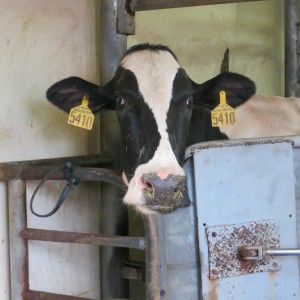
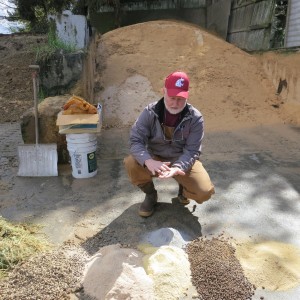
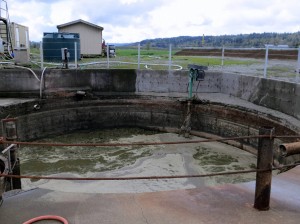
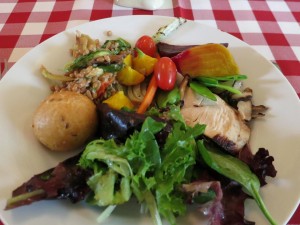
 About lorelle
About lorelle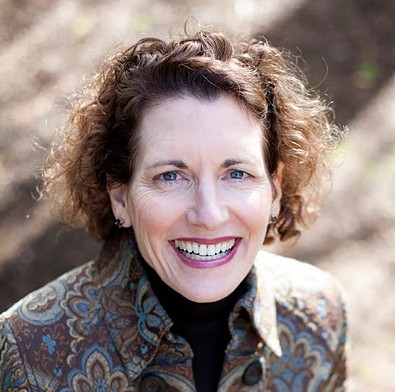
Very interesting post Lorelle…I think by learning the complexities of
our food and how the animals are tended with science and love helps
me to appreciate the entire process of cooking even more!.
As you said in your previous post about cooking to relieve stress coupled with
knowing about the farmer,farm and animal,veggie,fruit or grain helps
me to make this process a true meditation. thank you good work as
always…
Thanks Cheryl!
Great job on this piece, Lorelle! I felt as if I was right on the tour with you and learned so much about farming and how farmers work tirelessly to reduce their carbon footprint. Their love for their work, their farms and their animals really came through in your article. Bravo!
Thank-you Kim! It means so much from a pro like you.